Source: Trent Mongero, Winning Baseball
Until the pitcher is at least fifteen years old, he should learn to command two types of pitches: a fastball and a changeup. They will be doing themselves a big favour if they can throw both of these pitches for a strike, in most any count to the batter, by the time they enter high school. This way they have a foundation of the two primary pitches needed to compete and win.
Once they are fifteen or older, they should work to implement a breaking pitch by learning to throw a curveball or slider.
It is critical that they also continue to polish their fastball and changeup by learning to command them in and out of the strike zone. When a high school pitcher attempts to throw more than three pitches, his primary pitches tend to lose effectiveness, and the pitches all start to look similar to the batter.
A curveball should not be thrown as a primary pitch until a pitcher is at least fifteen or sixteen years old, and it is recommended that a slider not be thrown as a primary pitch until a player is at least seventeen years of age. By this age, a player should be physically strong enough and possess the correct mechanics to throw fastballs (two-seam and four-seam), changeups, and some type of breaking pitch. The key is that players must be able to command their pitches for a strike in the game; otherwise, they are generally useless pitches.
Keep in mind that there is more than one way to grip a baseball when throwing a pitch. Therefore, players should first be introduced to the basic grips of each primary pitch. Once they have a good feel for the delivery and location of a particular pitch, they can be shown other possible grip options to create more movement on the ball. At that point, they can spend time tweaking their grips and finger placement to determine what works best for them.
Fastballs and Changeups
Video: Fastball and Changeup (Winning Baseball) (4 mins.) ![]()
Four-Seam Fastball
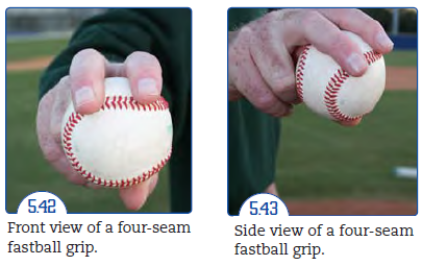
- The first pitch that must be mastered is the four-seam fastball.
- This is usually the easiest pitch to throw for a strike.
- If released properly, four laces of the ball rotate through the air, helping to keep the throw in line with the target.
- Pitchers should hold the baseball with their pointer and middle finger on the top laces or seams of the baseball. The pads of the fingers rest across the seams.
- The thumb should be underneath the ball, approximately splitting the distance of the top two fingers.
- The ring finger and pinky finger rest on the side of the ball to give it balance.
Two-Seam Fastball
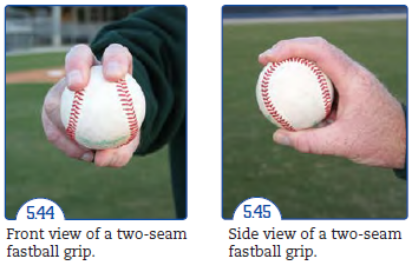
- After a pitcher can command the four-seam fastball for a strike, it is time to introduce him to a two-seam fastball.
- Will create some movement to help deceive the hitter.
- The main variation from the four-seam fastball is how the laces or seams of the ball are positioned in the fingers.
- When a two-seam fastball is properly released, the ball cuts through the air, moving naturally from right to left or left to right.
- Some pitchers have trouble controlling this for a strike because the ball can start off in the strike zone and drift out by the time it reaches the plate.
- Additional movement can be created with a two-seam fastball by holding the ball slightly off center, adjusting thumb placement, or holding the ball next to the seams instead of placing the pads of the fingers directly on the seams.
Circle or OK Changeup
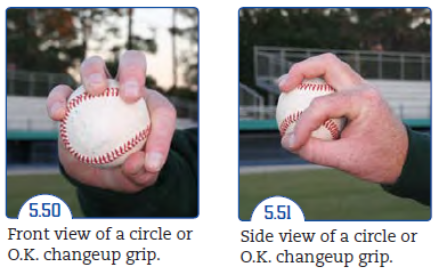
- A changeup is meant to deceive the hitter by appearing to be a fastball on release. However, it is just 8 to 12 miles per hour slower.
- The fastball action of the pitcher’s delivery will convince the hitter he is seeing a fastball; however, by the time he realizes it is a changeup, he will either swing early and miss, or the batter will hit the ball softly to the defense.
- For a circle changeup grip, the ball is held deeper in the hand or the palm than a fastball.
- The index finger slides off to the thumb side of the ball, and the pinky raises up on the opposite side of the ball.
- The changeup is a feel (touch) pitch, and it can be difficult for some players to throw a consistent strike using this grip.
- Don’t try to over pronate the hand. Let the grip and the natural pronation of the hand (where thumb turns down) take care of the pitch.
“C” Changeup: Variation of a Circle Changeup
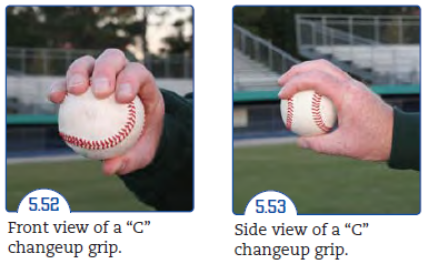
- The “C” changeup can be a good option for players who have smaller hands or have trouble with their feel for the circle changeup.
- To create the grip for a “C” changeup, a pitcher should attempt to hold the baseball like a football, where all four fingers line up opposite the thumb to make the letter “C.”
- To add movement, the ball can be gripped off-centre (where a portion of the ball protrudes out of the side of the hand between the thumb and index finger).
- This pitch is simply delivered with a four-seam or two-seam grip like the pitcher would throw his fastball.
- As the player’s hands grow or he gains more comfort with the feel of the pitch, he can gradually slide his index finger off the ball to the thumb side, and lift the pinky to create his circle change.
Curveball and Slider: Caution, 16+ Years Old
Video: Curveball and Slider (Winning Baseball) (6 mins.) ![]()
Curveball (16+ Years Old)
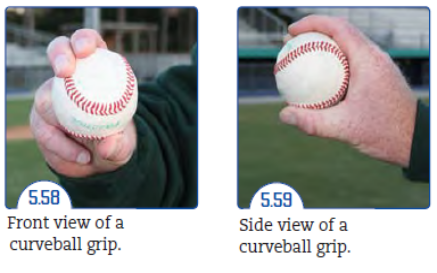
- If the curveball is thrown incorrectly, it can put a lot of stress on the elbow and shoulder. Therefore, this pitch should not be thrown until a player is sixteen years old.
- The curveball is an off-speed pitch that breaks more from top to bottom (i.e., from 12 o’clock to 6 o’clock); thus, it changes visual planes (from high to low) to the batter.
- The pitch is gripped by holding the ball off-centre with the index finger and middle finger side by side. The fingers rest beside the seam that creates the horseshoe, and the thumb rests on the opposite seam on the bottom of the ball.
- The curveball is initially thrown like a fastball until the hand gripping the ball gets beside the pitcher’s head, where his fingers will move to the outside of the ball.
- At that point, the pitcher will attempt to slice the batter in half with his pointer and middle fingers, and then continue down in front of his body and finish by simulating stabbing himself in the thigh of his landing leg (or pulling down the cord of a window shade).
- This creates the top spin that will pull the ball down as it travels to the plate.
Slider (16+ Years Old)
- The slider puts extra stress on the pitcher’s elbow and should not be thrown until a pitcher is sixteen years old.
- The slider is thrown with fastball velocity but has late-breaking diagonal tilt (i.e., from 2 o’clock to 7 o’clock or 3 o’clock to 8 o’clock); thus, it fools the hitter by possessing fastball speed but also changing visual planes.
- The slider is gripped similarly to the curveball but held against the seams where the horseshoe comes back close together, and is released in a manner that will create tight spin (many rotations in a short period of time).
- The slider is thrown like a fastball until the ball gets close to the release point.
- To create the tight spin of a slider, the pitcher will replace his thumb with the big knuckles of his index finger and middle finger. This wrist action maintains most of the pitch velocity and gives it the desired late-breaking tilting action to make hitters swing and miss.
Specific Ideas to Reinforce Pitching Grips
Throwing Drills—Encourage pitchers to alternate a four-seam grip, two-seam grip, and changeup grip when executing throwing drills or playing catch.
Pitching Drills—Suggest that pitchers implement a four-seam grip, two-seam grip, changeup grip, and curveball grip when executing specific pitching drills.
Throwing Long—Encourage pitchers to alternate using a changeup grip with fastball grips when throwing long. This helps players maintain good arm speed with the grip, which is essential to throwing a good changeup.
Guessing Game—Pitchers should vary their grips when throwing with a coach, teammate, or catcher. The receiver of the pitch should try to correctly identify the grip used for every throw. The goal of the pitcher is to make it difficult for the person to identify the grip based on the release of the ball. The difference in ball speed and/or movement should be how the partner determines the grip or type of pitch.
Kneeling Curveball Practice—Pitchers should get into a kneeling position with their front knee up and their back knee on the ground. The front foot should be pointed to their partner but slightly closed (ten degrees of less). The player’s front shoulder should be pointed at their partner with his hands together at the position they separate in his delivery (by the navel). The goal of the pitcher is to create consistent upper body positioning and arm action to allow for proper rotation of the ball. This includes fastball action of the throwing hand until the ball gets beside the pitcher’s head. The pitcher should then attempt to slice the batter in half with his pointer and middle fingers, continuing down to simulate stabbing himself in the thigh of his landing leg. However, since he is in a kneeling position, the hand will finish beside his glove-side ankle. This same drill can be done standing. However, it is best performed from a “post-stride” position. Therefore, the pitcher must take his stride prior to completing the action of the upper body, as he did from the kneeling position.


